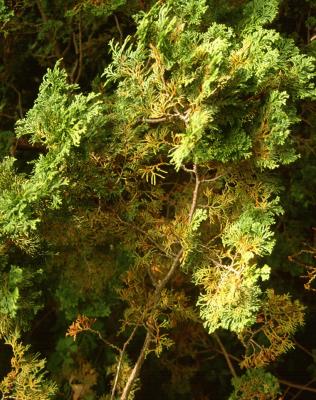
Symptoms may be visible between two to three weeks after infection. The pathogen is able to over winter in the infected foliage on the trees. The disease usually starts near the base of the plant and works upward. It also starts usually on the inner foliage and works outward. The affected foliage turns bronze to light brown color then grayish. Small, fuzzy or hairy spore-bearing structures, easily seen with a hand lens, form on the dead foliage. Eventually the dead foliage and twigs falls off the branch. With time all the inner foliage and twigs are gone, leaving only foliage at the very tips of the branches. Occasionally adventitious buds may develop new growth on the "naked " lower branches. Left uncontrolled, the tips of the lower branches die too. Thus leaving only green growth at the very top of the plant. On highly susceptible trees, the fungus can also kill the entire plant, sometimes in as little as three years. Initially the green tips of the affected branches help to separate this disease from Phomopsis and Kabatina Blights. Phomopsis and Kabatina kill from infection (canker or wound) out to the tip in the same growing season.